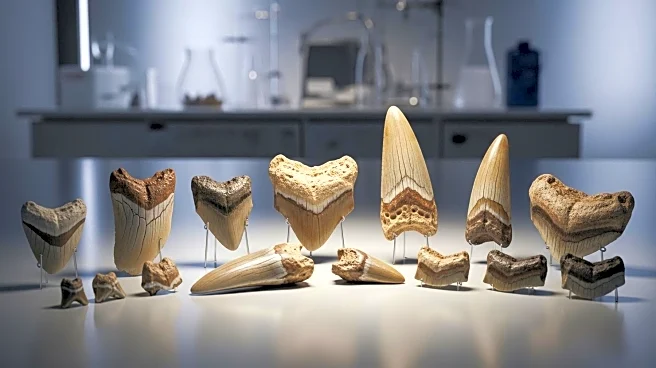What is the story about?
What's Happening?
Researchers at The University of Texas at Austin have discovered insights into the dietary habits of dinosaurs by analyzing calcium isotopes in their tooth enamel. The study, led by Liam Norris, reveals that different dinosaur species had distinct dietary preferences, which allowed them to coexist in the same ecosystem. The research focused on four dinosaur species and one crocodyliform from the Late Jurassic period, whose remains were found in the Carnegie Quarry deposit in northeast Utah. The findings suggest that herbivorous dinosaurs like Camarasaurus, Camptosaurus, and Diplodocus had varied diets, ranging from conifers to softer plant parts like leaves and buds. The study also examined carnivorous species such as Allosaurus and Eutretauranosuchus, revealing potential dietary overlaps.
Why It's Important?
This research provides a deeper understanding of how large herbivorous dinosaurs coexisted by consuming different plant parts rather than just different canopy levels. The findings challenge previous assumptions and offer new insights into the ecological dynamics of the Late Jurassic period. By understanding these dietary distinctions, scientists can better comprehend the biodiversity and plant productivity of ancient ecosystems. The study also contributes to theories about the physical adaptations of dinosaurs, such as the flexible necks of long-necked species, which may have allowed them to access various vegetation levels without moving their bodies extensively.
What's Next?
Future research may focus on further exploring the dietary habits of other dinosaur species and their ecological interactions. The study's methodology could be applied to other fossil sites to gain a broader understanding of dinosaur ecosystems. Additionally, the findings may inspire new investigations into the evolutionary adaptations of dinosaurs in response to their dietary needs and environmental changes.
Beyond the Headlines
The study highlights the importance of geochemical analysis in paleontology, offering concrete evidence to support theories about dinosaur behavior and ecology. It also underscores the significance of preserving fossil sites like the Carnegie Quarry, which provide invaluable insights into prehistoric life. The research may influence how scientists interpret the fossil record and reconstruct ancient ecosystems.
AI Generated Content
Do you find this article useful?
















